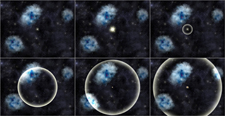CXC Home | Search | Help | Image Use Policy | Latest Images | Privacy | Accessibility | Glossary | Q&A
1
Chandra X-ray Image of SNR 0509-67.5
A Chandra X-ray Observatory image of the supernova remnant SNR 0509-67.5 in the Large Magellanic Cloud. The lowest energy X-rays are shown in red, the intermediate energies are green and the highest energies are blue. In 2004, scientists used Chandra to show that SNR 0509-67.5 was likely caused by a Type Ia supernova, using an analysis of the elements, such as silicon and iron, that were detected. A Type Ia is thought to result from a white dwarf star in a binary system that reaches a critical mass and explodes. In the new X-ray study of SNR 0509-67.5, spectra from Chandra and ESA's XMM-Newton Observatory were used to calculate the amount of energy involved in the original explosion, using an analysis of the supernova remnant and state-of-the-art explosion models.
(Credit: NASA/CXC/Rutgers/J.Warren, J.Hughes)
A Chandra X-ray Observatory image of the supernova remnant SNR 0509-67.5 in the Large Magellanic Cloud. The lowest energy X-rays are shown in red, the intermediate energies are green and the highest energies are blue. In 2004, scientists used Chandra to show that SNR 0509-67.5 was likely caused by a Type Ia supernova, using an analysis of the elements, such as silicon and iron, that were detected. A Type Ia is thought to result from a white dwarf star in a binary system that reaches a critical mass and explodes. In the new X-ray study of SNR 0509-67.5, spectra from Chandra and ESA's XMM-Newton Observatory were used to calculate the amount of energy involved in the original explosion, using an analysis of the supernova remnant and state-of-the-art explosion models.
(Credit: NASA/CXC/Rutgers/J.Warren, J.Hughes)
2
Illustration of Light Echoes and a Supernova Remnant
This sequence of artist's illustrations begins with a view of a bright, massive star in the center, surrounded by several dust clouds. A bright flash of light marks the destruction of the star in a supernova explosion. As time passes the supernova dims and its light spreads outwards, eventually reflecting off the dust clouds to create light echoes. A supernova remnant eventually appears at the site of the supernova explosion, and increases in size with time.
(Credit: NASA/CXC/M.Weiss )
This sequence of artist's illustrations begins with a view of a bright, massive star in the center, surrounded by several dust clouds. A bright flash of light marks the destruction of the star in a supernova explosion. As time passes the supernova dims and its light spreads outwards, eventually reflecting off the dust clouds to create light echoes. A supernova remnant eventually appears at the site of the supernova explosion, and increases in size with time.
(Credit: NASA/CXC/M.Weiss )
3
Light Echoes from the Supernova that Produced SNR 0509-67.5
This sequence of images shows light echoes from the supernova explosion that caused the remnant SNR 0509-67.5 to form. This CTIO 4m telescope optical image shows light from the original supernova explosion that has bounced off dust clouds in the neighboring regions of the Large Magellanic Cloud (the light echoes are shown in blue and stars in orange). The light from these echoes travels a longer path than the light that travels straight toward us, and so can be seen hundreds of years after the supernova itself. The 5 images were taken between 2001 and 2006 and are shown separately in a time-lapse movie.
(Credit: NOAO/CTIO/Harvard/A.Rest et al)
This sequence of images shows light echoes from the supernova explosion that caused the remnant SNR 0509-67.5 to form. This CTIO 4m telescope optical image shows light from the original supernova explosion that has bounced off dust clouds in the neighboring regions of the Large Magellanic Cloud (the light echoes are shown in blue and stars in orange). The light from these echoes travels a longer path than the light that travels straight toward us, and so can be seen hundreds of years after the supernova itself. The 5 images were taken between 2001 and 2006 and are shown separately in a time-lapse movie.
(Credit: NOAO/CTIO/Harvard/A.Rest et al)
4
Optical Panoramic Image of the Large Magellanic Cloud
This panoramic optical image of the Large Magellanic Cloud (LMC) is from the Magellanic Cloud Emission Line Survey (MCELS), obtained with the University of Michigan's 0.9-meter Curtis Schmidt telescope at CTIO. Emission lines of hydrogen (H-alpha) are red, singly-ionized sulfur is green and doubly-ionized oxygen is blue. The image highlights regions of star formation in the LMC, including supernova remnants and giant structures carved out by multiple supernovas.
(Credit: NOAO/AURA/NSF/S.Points, C.Smith & MCELS team)
This panoramic optical image of the Large Magellanic Cloud (LMC) is from the Magellanic Cloud Emission Line Survey (MCELS), obtained with the University of Michigan's 0.9-meter Curtis Schmidt telescope at CTIO. Emission lines of hydrogen (H-alpha) are red, singly-ionized sulfur is green and doubly-ionized oxygen is blue. The image highlights regions of star formation in the LMC, including supernova remnants and giant structures carved out by multiple supernovas.
(Credit: NOAO/AURA/NSF/S.Points, C.Smith & MCELS team)
Return to SNR 0509 (March 20, 2008)











